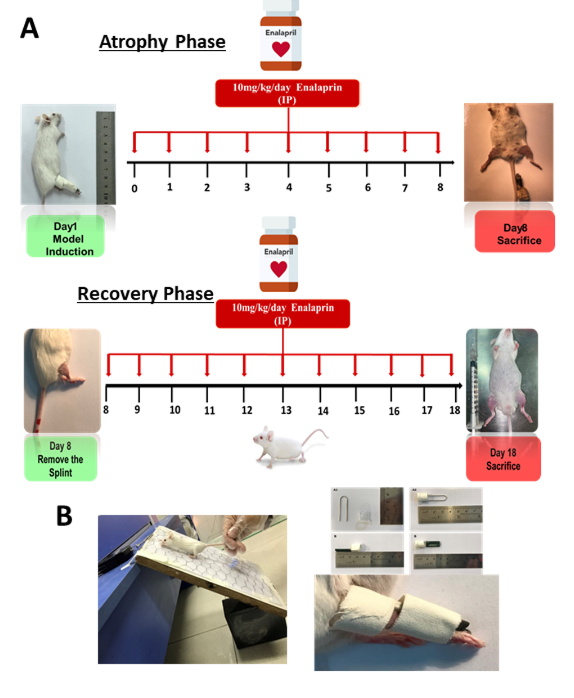The therapeutic potential of angiotensin-converting enzyme inhibitor enalapril to ameliorate muscle atrophy in a murine model
DOI:
https://doi.org/10.17179/excli2023-6822Keywords:
muscle atrophy, limb immobilization, oxidative stress, enalapril, inflammation, renin-angiotensin systemAbstract
Muscle atrophy due to limb immobilization and inactivity is a common consequence of many diseases and treatment processes. One of the systems activated in inflammatory conditions is the renin-angiotensin system (RAS). The present study was conducted with the aim of investigating the effects of one of the angiotensin-converting enzyme (ACE) inhibitors, enalapril, on improving muscle atrophy caused by immobility. The study was conducted in three groups: a control, an atrophy, and an atrophy group treated with enalapril on Balb/c mice. After tying a splint to cause atrophy in one of the legs, daily treatment with enalapril intraperitoneally (dissolved in DMSO) at a dose of 10 mg/kg/day was done for 7 days. On the eighth day, the splint was opened and half of the mice were evaluated. Then, in the recovery phase, treatment with enalapril was continued in the remaining mice for 10 days without a splint. At the end of each phase, the mice were examined for the muscle strength of the lower limb muscles, and histological and biochemical analyses were subsequently carried out. The tissue level of the oxidative stress index MDA was evaluated, which showed a significantly lower level in the enalapril group compared to the atrophy group (*P<0.1). Also, inflammatory factors in the enalapril group showed a decrease compared to the atrophy group. The strength of four limbs in the mice of the treatment group (-18.36 ± 1.70 %) was significantly higher than that of the atrophy group (-30.33 ± 3 %) at the end of the atrophy phase and also after 10 days of recovery. The results suggest that the use of enalapril that reduces the activation of angiotensin II-dependent pro-oxidant and pro-inflammatory pathways may improve the functional disorder and muscle necrosis in the murine model of muscle atrophy.

Downloads
Additional Files
Published
How to Cite
License
Copyright (c) 2024 Sima Seifi, Seyedeh Elnaz Nazari, Amir Avan, Nima Khalili-Tanha, Fereshteh Asgharzadeh, Fatemeh Babaei, Ghazaleh Khalili-Tanha, Seyyedeh Zahra Asghari, Mahdieh Darroudi, Gordon A. Ferns, Abdoljalal Marjani, Majid Khazaei

This work is licensed under a Creative Commons Attribution 4.0 International License.
Authors who publish in this journal agree to the following terms:
- The authors keep the copyright and grant the journal the right of first publication under the terms of the Creative Commons Attribution license, CC BY 4.0. This licencse permits unrestricted use, distribution and reproduction in any medium, provided that the original work is properly cited.
- The use of general descriptive names, trade names, trademarks, and so forth in this publication, even if not specifically identified, does not imply that these names are not protected by the relevant laws and regulations.
- Because the advice and information in this journal are believed to be true and accurate at the time of publication, neither the authors, the editors, nor the publisher accept any legal responsibility for any errors or omissions presented in the publication. The publisher makes no guarantee, express or implied, with respect to the material contained herein.
- The authors can enter into additional contracts for the non-exclusive distribution of the journal's published version by citing the initial publication in this journal (e.g. publishing in an institutional repository or in a book).





